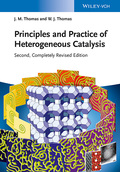Principles and Practice of Heterogeneous Catalysis

2. Auflage Dezember 2014
768 Seiten, Softcover
300 Abbildungen (300 Farbabbildungen)
Lehrbuch
Kurzbeschreibung
Kernprinzipien verständlich präsentiert - die lang erwartete 2. Auflage dieser Einführung in die Grundlagen der heterogenen Katalyse wurde vollständig überarbeitet und aktualisiert.
This long-awaited second edition of the successful introduction to the fundamentals of heterogeneous catalysis is now completely revised and updated.
Written by internationally acclaimed experts, this textbook includes fundamentals of adsorption, characterizing catalysts and their surfaces, the significance of pore structure and surface area, solid-state and surface chemistry, poisoning, promotion, deactivation and selectivity of catalysts, as well as catalytic process engineering. A final section provides a number of examples and case histories.
With its color and numerous graphics plus references to help readers to easily find further reading, this is a pivotal work for an understanding of the principles involved.
1 Setting the Scene
1.1 Prologue: Advances since the Early 1990s.
1.2 Introduction
1.3 Perspectives in Catalysis: Past, Present, Future
1.4 Definition of Catalytic Activity
1.5 Key Advances in Recent Theoretical Treatments: Universability in Heterogeneous Catalysis
1.6 Milestones Reached in Industrial Catalysis in the 20th Century, and Some Consequential Challenges
2 The Fundamentals of Adsorption: Structural and Dynamical Considerations, Isotherms, and Energetics
2.1 Catalysis Must Always be Preceded by Adsorption
2.2 The Surfaces of Clean Solids are Sometimes Reconstructed
2.3 There are Many Well-Defined Kinds of Ordered Adlayers
2.4 Adsorption Isotherms and Isobars
2.5 Dynamical Considerations
2.6 Relating the Activation Energy to the Energy of Chemisorption. Universality in Heterogeneous Catalysis and the BrØnsted-Evans-Polanyi (BEP) Relation.
2.7 Deriving Adsorption Isotherms from Kinetic Principles
2.8 Energetics of Adsorption
2.9 Mobility at Surfaces
2.10 Kinetics of Surface Reactions
2.11 Autocatalytic, Oscillatory, and Complex Heterogeneous Reactions
2.12 Microkinetics: A Summary
3 The Characterization of Industrial and Model Solid Catalysts
3.1 Non-Invasive Methods Suitable for Studies Involving Catalytic Reactors
3.2 A Portfolio of Modern Methods: Introducing the Acronyms
3.3 Which Elements and Which Phases are Present?
3.4 Probing Surfaces with IR, HREELS, AES and XPS
3.5 Ultraviolet-Visible and Photoluminescence Spectroscopy
3.6 The Structure and Crystallography of Surfaces: Nature of Ordered and Reconstructed Surfaces
3.7 Other Structural Techniques for Characterizing Bulk and Surfaces of
Catalysts
3.8 A Miscellany of Other Procedures
3.9 Determining the Strength of Surface Bonds: Thermal and Other Temperature-Programmed Methods
3.10 Reflections on the Current Scene Pertaining In Situ Methods of Studying Catalysts
4 Porous Catalysts: Their Nature and Importance
4.1 Definitions and Introduction
4.2 Determination of Surface Area
4.3 Mercury Porosimetry
4.4 Wheeler´s Semi-Empirical Pore Model
4.5 Diffusion in Porous Catalysts
4.6 Chemical Reaction in Porous Catalyst Pellets
5 Solid State Chemical Aspects of Heterogeneous Catalysts
5.1 Recent Advances in Our Knowledge of Some Metal Catalysts: Extended and in Cluster or Nanoparticle States
5.2 Comments on the Catalytic Behaviour of Nanogold
5.3 Recent Advances in the Elucidation of Certain Metal-Oxide Catalysts
5.4 Atomic-Scale Edge Structures in Industrial-Style MoS2 Nanocatalysts
5.5 Open-Structure Catalysts: From 2D to 3D
5.6 Computational Approaches
5.7 A Chemist´s Guide to the Electronic Structure of Solids and Their Surfaces
5.8 Key Advances in Recent Theoretical Treatments of Heterogeneous Catalysis
5.9 Selected Applications of DFT to Catalysis
5.10 Concluding Remarks Concerning DFT Calculations in Heterogeneous Catalysis
6 Poisoning, Promotion, Deactivation and Selectivity of Catalysts
6.1 Background
6.2 Catalyst Deactivation
6.3 Some Modern Theories of Poisoning and Promotion
7 Catalytic Process Engineering
7.1 Novel Operating Strategies
7.2 Traditional Catalytic Reactors
8 Heterogeneous Catalysis: Examples, Case Histories, Current Trends
8.1 The Synthesis of Methanol
8.2 Fisher-Tropsch Catalysis
8.3 Synthesis of Ammonia
8.4 Oxidation of Ammonia: Stepping Towards the Fertilizer Industry
8.5 In-Situ Catalytic Reaction and Separation
8.6 Automobile Exhaust Catalysts and the Catalytic Monolith
8.7 Photocatalytic Breakdown of Water and the Harnessing of Solar Energy
8.8 Catalytic Processes in the Petroleum Industry
9 Powering the Planet in a sustainable manner: some of tomorrow´s catalysts (actual and desired) and key catalytic features pertaining to renewable feedstocks, green chemistry and clean technology
9.1 Introduction
9.2 Powering the Planet with Solar Fuel
9.3 Some Significant Advances in Photo-assisted Water Splitting and Allied Phenomena
9.4 The Hydrogen Economy
9.5 Some of Tomorrow´s Catalysts: Actual and Desired
9.6 A Biorefinery Capable of Producing Transportation Fuels and Commodity Chemicals
9.7 Non-Enzymatic Catalytic Processing of Biomass-Derived Raw Materials to Selected
9.8 Strategies for the Design of New Catalysts
9.10 Solar-Driven Catalysed Thermochemical Reaction as Alternatives to
Fossil-Fuel
W. John Thomas, FR Eng, is Professor Emeritus of Chemical Engineering at the University of Bath.


